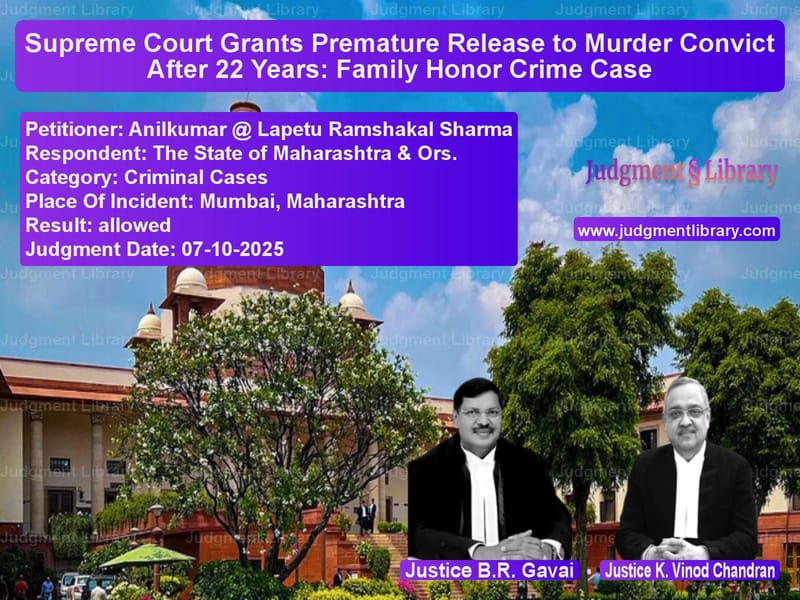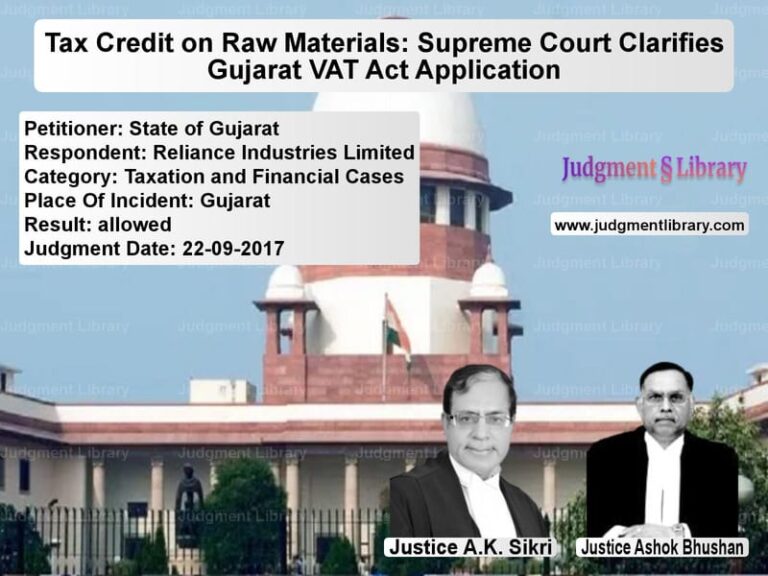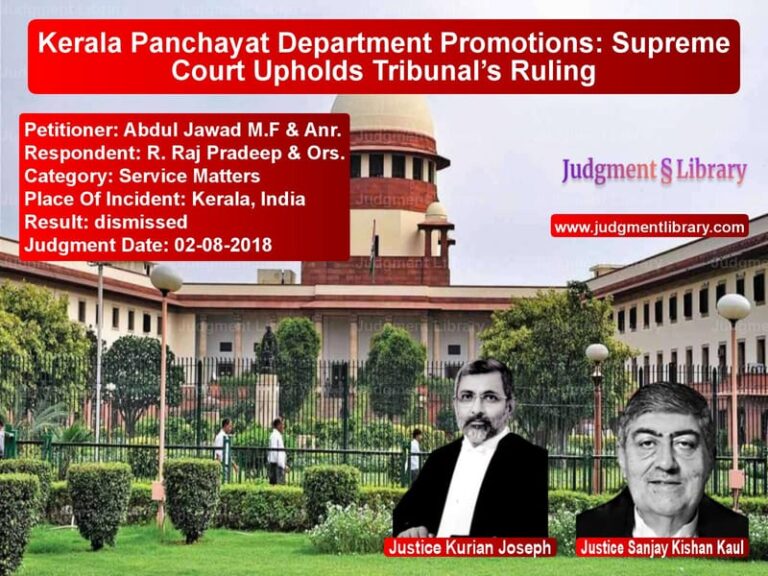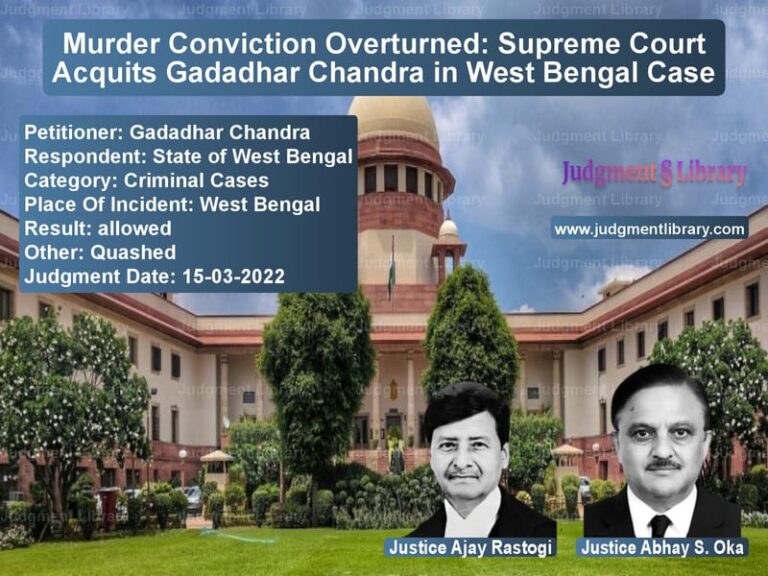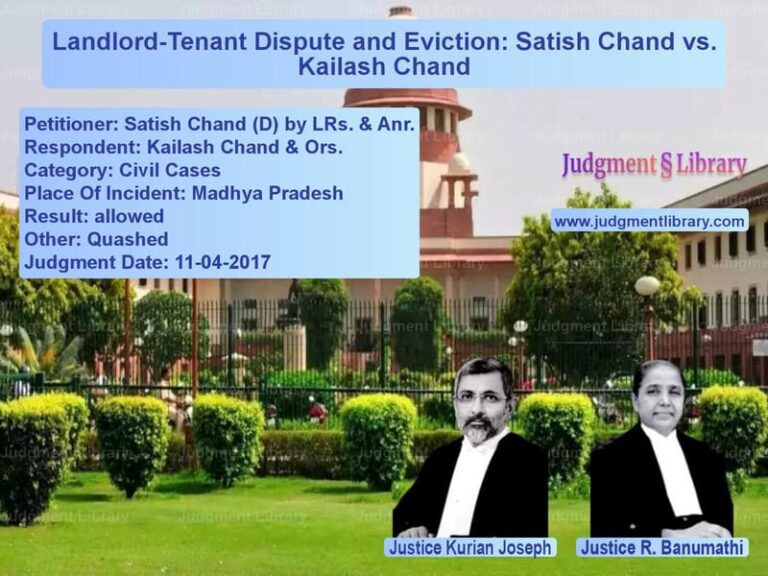Supreme Court Grants Premature Release to Murder Convict After 22 Years: Family Honor Crime Case
In a significant judgment that examines the nuances of remission policies and the concept of justice in long-term incarceration cases, the Supreme Court has granted premature release to a life convict who had served nearly 22 years in prison for a murder committed when he was just past 18 years old. The case delves into the complex interplay between punishment, rehabilitation, and the proper application of government remission guidelines.
The legal proceedings involved Anilkumar @ Lapetu Ramshakal Sharma, a life convict seeking premature release after almost 20 years of incarceration. The appellant had approached the Government for remission of his life sentence, which led to a detailed examination of the 2010 guidelines framed for premature release and their proper categorization in his particular case.
The Crime and Initial Proceedings
The appellant had been convicted and sentenced to imprisonment for life under Section 302 (murder) and 7 years rigorous imprisonment under Section 307 (attempt to murder) of the Indian Penal Code, with both sentences to be undergone concurrently. The crime involved the appellant along with a second accused attacking the deceased and his friend in what was established as a premeditated attack.
The prosecution’s case revealed that the motive behind the crime was that the deceased was in love with the appellant’s sister, and the appellant believed this relationship was spoiling his sister’s life and tarnishing the family’s reputation. This crucial detail about the motive would later become central to the Supreme Court’s analysis of which remission category properly applied to the appellant’s case.
The Remission Controversy
The Government, upon the appellant’s application for remission, procured a report from the Additional District Court, Greater Mumbai – the same court that had initially convicted the appellant and passed the sentence. Based on the opinion of the learned Additional Sessions Judge that the act committed by the appellant fell within the purview of Category 4(d) of the 2010 guidelines framed for premature release, the Government through its Home Department directed his release after 24 years of incarceration.
The appellant contested this categorization, arguing that he ought to have been released after 22 years under a different category. The bone of contention was whether the appellant’s crime fell under Category 4(d), which refers to “a person who committed a murder jointly with another person, with premeditation,” or under Clause 3(b), which covers “a crime committed with premeditation individually or by a gang, of a murder arising inter alia out of family prestige.”
Arguments Before the Supreme Court
Before the Supreme Court, the learned counsel for the appellant presented the case for categorization under Clause 3(b), emphasizing that the crime was motivated by concerns about family prestige. The appellant’s legal team argued that the specific nature of the motive placed the case squarely within the family prestige category rather than the general joint murder category.
On the other side, the learned Government Advocate appearing for the respondents defended the Government’s decision, submitting that “the guidelines are clear and the order is issued in tandem with the same.” The Government maintained that “the appellant has to serve two more years for release” as per their categorization under Category 4(d).
The Supreme Court’s Analysis
The Supreme Court conducted a thorough examination of the guidelines framed by the Government for considering remission and the specific facts of the case. The Court noted that “the appellate Court has specifically noticed” the motive related to family prestige “and so has the Government in the impugned order.”
In a crucial observation, the Court stated that “hence, obviously the crime is one to uphold the family prestige, which in the given circumstances could mean the perceived tarnishing of the family’s name, though not condonable, the appellant has a valid case for remission after almost 22 years of incarceration.”
The Court examined the custody certificate attached to the Writ Petition, which indicated that “the appellant has been in custody for 20 years 7 months and 8 days as on 30.09.2024.” By the time of the Supreme Court hearing, the appellant had been in custody for almost 22 years, short of just three months.
The Supreme Court found merit in the appellant’s contention regarding the proper categorization, holding that “the category under which the remission ought to have been considered was 3(b) under Government Resolution No. RLP No.1006/CR621/PRS-3 dated 15.03.2010.”
The Court’s Humanitarian Approach
In a display of judicial compassion and practical reasoning, the Supreme Court made a significant observation about the remaining three months of incarceration. The Court stated that “We are also of the opinion that three months more in jail would make no difference; neither added solace to the family of the victim nor extra remorse to the accused.”
This reasoning reflects the Court’s understanding that the additional three months of imprisonment would serve no penological purpose – it would neither provide additional comfort to the victim’s family nor generate greater remorse in the convict who had already served nearly 22 years.
The Court also took note of the appellant’s age at the time of the crime, specifically mentioning that “the appellant was just past 18 years on the date of the crime.” This factor likely influenced the Court’s decision, as it highlighted the appellant’s youth and potentially diminished maturity at the time of committing the offense.
The Final Ruling
Based on its analysis, the Supreme Court allowed the appeal and directed “the release of the appellant forthwith.” The Court’s decision effectively corrected what it saw as a misapplication of the remission guidelines by the Government authorities.
The judgment demonstrates the Supreme Court’s role in ensuring that government policies, including remission guidelines, are applied correctly and fairly. By intervening in this case, the Court prevented what would have been an additional two years of incarceration based on an incorrect categorization of the crime.
Broader Implications
This judgment has significant implications for the criminal justice system, particularly regarding the application of remission policies and the consideration of motive in categorization of crimes for premature release purposes. The Court’s recognition that crimes motivated by “family prestige” constitute a distinct category with different considerations for remission highlights the nuanced approach required in such matters.
The decision also reinforces the principle that remission policies should be applied with careful attention to the specific circumstances of each case, rather than through rigid, mechanical application of categories. The Court’s willingness to examine the actual motive behind the crime, rather than just its legal classification, represents a more holistic approach to justice.
Furthermore, the Court’s pragmatic assessment that an additional three months of imprisonment would serve no meaningful purpose reflects a modern understanding of penology that emphasizes rehabilitation and reintegration over pure retribution, especially for someone who has already served more than two decades in prison.
The case serves as an important precedent for similar matters where the proper categorization under remission guidelines is disputed, and where individuals have already served substantial periods of incarceration. It underscores the judiciary’s role in ensuring that executive decisions regarding remission are made in accordance with established guidelines and principles of fairness.
Petitioner Name: Anilkumar @ Lapetu Ramshakal Sharma.Respondent Name: The State of Maharashtra & Ors..Judgment By: Justice B.R. Gavai, Justice K. Vinod Chandran.Place Of Incident: Mumbai, Maharashtra.Judgment Date: 07-10-2025.Result: allowed.
Don’t miss out on the full details! Download the complete judgment in PDF format below and gain valuable insights instantly!
Download Judgment: anilkumar-@-lapetu-r-vs-the-state-of-maharas-supreme-court-of-india-judgment-dated-07-10-2025.pdf
Directly Download Judgment: Directly download this Judgment
See all petitions in Murder Cases
See all petitions in Judgment by B R Gavai
See all petitions in Judgment by K. Vinod Chandran
See all petitions in allowed
See all petitions in supreme court of India judgments October 2025
See all petitions in 2025 judgments
See all posts in Criminal Cases Category
See all allowed petitions in Criminal Cases Category
See all Dismissed petitions in Criminal Cases Category
See all partially allowed petitions in Criminal Cases Category

